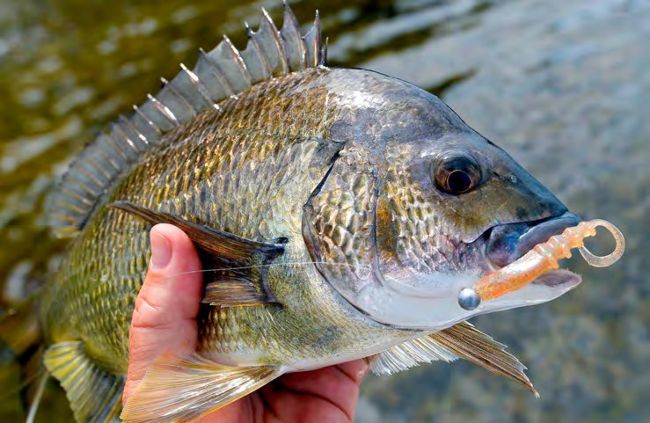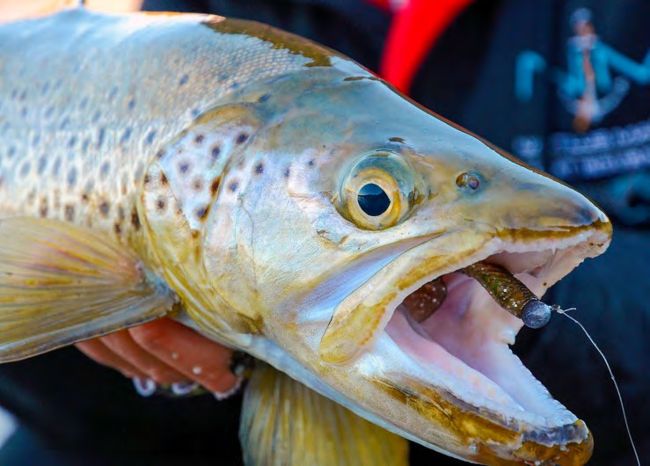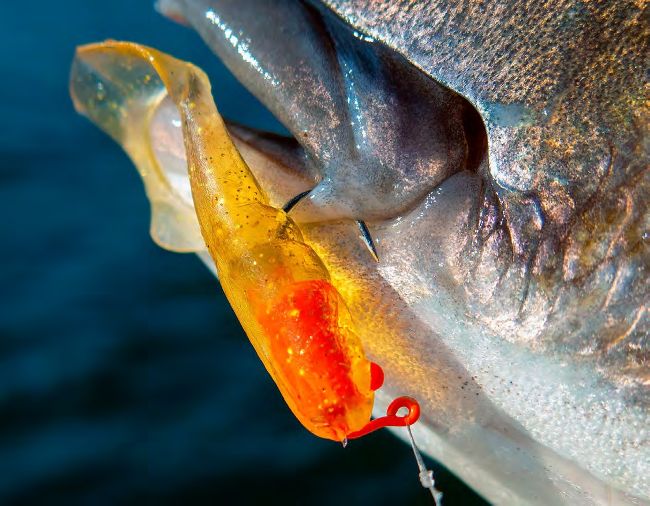USING YOUR HEAD!
The Lowdown On Jig Heads
As Starlo tells it, there’s a bit more to jig head selection than many soft plastic fishers realise!
Considering the extensive media coverage devoted to fishing with soft plastics these days, it’s surprising how little attention is paid to the “delivery vehicles” used to actually get these lures in front of fish. In other words: the hooks, weights, jig heads and other bits of paraphernalia we rig our plastics on.
Fact is, the best soft plastic tails on the market are useless as fishcatching tools without the addition of a hook and also, in many instances, some extra weight to allow longer casting and also to carry the lure down through the water column to the desired fishing depth.
There are a number of ways of achieving these goals. Plastics can be rigged on standard hooks of the type used for bait fishing, or on specially-shaped (often wide-gape) “worm” hooks, and then weighted with fixed or running sinkers of various styles. These sinkers or weights can be placed either above (in front of) the plastic, or below it, as is the case when using a paternoster or “drop-shot” style set-up. Believe it or not, soft plastics can also be suspended under floats, and although this technique hasn’t been all that common in Australia waters in the past, a few anglers are giving it a go, of ten with surprisingly good results.
Of course, some soft plastics are also sold pre-rigged, or have integrated, internal weights with built-in hooks and hook connections. These integrated plastics are viable alternatives, especially for newcomers to plastic fishing, or those who only dabble with them. On the other hand, more serious users of softies tend to prefer the flexibility (and long-term economy) of the modular system: mixing and matching their own tails, hooks and weights to suit changing conditions.
All of the possible presentation alternatives — pre-rigged plastics, un-weighted presentations, “weedless” or “snag-proof” rigs, drop-shotting, Texas and Carolina rigging with fixed or running sinkers, Ned rigs, float-suspended plastics and even oddball presentations such as the “wacky rigs” — have a place in the arsenal of the complete soft plastic angler. (You can Google any of them and find lots more info’ on-line.) But I want to concentrate here on what is by far the most common and popular of all plastic presentation vehicles for most Australian fishing conditions: the humble jig head. on top of the finished round lead or alloy head: on the same plane as the hook bend and hook point.
These jig heads also generally have some form of holding device or “keeper” to help secure the plastic tail snugly against the weight on the hook. The result is a jig that sinks and rides point-up in the water, significantly reducing (but certainly not eliminating) snagging or fouling with weed.
TWEAKING THE VARIABLES
By changing the design features of jig heads, manufacturers can tailor them to do different jobs.
For example, jigs intended to catch big, powerful fish living in snag-strewn waters call for heavy-gauge, extra-strong jig hooks. There will be a price to pay for this, because you’ll often need a little extra force to drive such a thick hook into a fish’s jaw. By contrast, if you’re targeting fish that live in open water, you might choose a jig built on a very fine, light-gauge hook. This hook will have the best possible penetration characteristics, especially at longer casting ranges and on lighter tackle. Although not as strong as a heavy-gauge hook, on the relatively light line and drag
GETTING JIGGY WITH IT
In soft plastic fishing, a jig or jig head is simply a hook incorporated into a built-in sinker or weight. Within that broad definition, there are an incredible array of possibilities in terms of hook pattern and size, head shape, head weight, head density, construction material, tail keeper set-up, weed or snag guard… and so on.
The simplest (and most popular) jig heads consist of a straight-shanked, round-bend, Aberdeen-style hook with an unpainted or painted spherical head made of lead or a lead alloy. Traditionally, these jigs are built on purpose-made jig hooks that have a 60 to 90 degree bend in the shank near the hook eye. These hooks are placed in a mold and the molten alloy poured in to form the head around that shank bend. This configuration places the hook eye settings that can be used in open water, this fine hook shouldn’t bend or break. Keen, versatile soft plastic users will have examples of both of these jig head styles in their tackle box (as well as everything in between), ideally in a range of weights and hook sizes to suit the plastics they use and the fish they chase.

The time-proven round-head, unpainted jig head is so effective in many scenarios, but you still need to get the weight and size right — and rig the tail on it correctly

Jig-head-rigged soft plastics remain an under-utilised tool in freshwater fishing. Trout, redfin, callop and cod all respond well to them… as do carp!
Matching the hook size (length and gape) to the tail you choose to use is mostly a matter of common sense. Hooks that are way too big or too small for a particular tail simply look wrong and don’t work all that well. There’s a degree of flexibility in all of this, although hook size can be quite critical at times. The gape of the hook needs to be wide enough to allow for easy rigging of the plastic and to provide good point exposure, but not so large as to throw the lure out of whack, nor make it look unnatural and unbalanced. Like I said, it’s mostly common sense.
Small barbs are also favoured on modern jig hooks, and the over-sized “ski jump” barbs of yesteryear really have little place in sophisticated soft plastic tweaking. In fact, increasing numbers of anglers are choosing to squash their barbs down and go completely barbless. While this might cost the odd fish (especially on jumpers like trout and Aussie salmon), it’s also kinder to fish and anglers, makes for speedier hook removal, and prolongs the life of rubber tails, which stand much less chance of being damaged as you wrestle to remove the jig head from a struggling fish.
Choosing the optimum weight jig head can be a slightly trickier matter than picking the right hook. Trial and error will often show you the right one to use in any given set of circumstance, and you’ll eventually develop an innate “feel” for picking the right heads to suit the prevailing conditions.
In many finesse situations— particularly where fish are becoming increasingly choosy and difficult to tempt—using the lightest head practical can sometimes be a key to getting more bites. However, note my use of the word “practical”. It’s no use going so light that you simply can’t cast the lure far enough to reach the fish, or get it down in front of their face through a deep, swiftly flowing current. It can also be counter-productive to use a head so light that the tail refuses to “swim” on the drop, while the jig is sinking. This last point is an important and often-overlooked consideration, and it’s well worth watching how various head weights influence the swimming action of different tails as they sink on a slack or semi-slack line.
HANG TIMES & KEEPERS
Head weights and sink rates directly influence what I like to call “hang time”: in other words, the period a lure spends falling through a particular strike zone. Increasing hang time can increase strikes in some situations.
One way to extend hang times is to use jig heads made from lighter materials such as aluminium or various plastic resins. These approaches provides the bulk to match bigger tails and carry hefty hooks, but at a considerably lighter density, to prolong those all-important hang times in and around snags or over weed beds. Nowadays, you’ll find such offerings on the market (if you search hard enough), allowing you to play around with those all-important sink rates and hang times.
Speaking of jig head variables, the design of any holding device, keeper or collar on a jig is quite important as well. Most jig heads also come equipped with a keeper or keepers. These devices are intended to secure the soft plastic tail to the hook or jig head, prevent it twisting or sliding out of alignment. Keepers also resist the tendency for a biting fish to drag the rubber tail down into the bend of the hook.
Many jig heads feature a fairly fat lead collar, often with one or more lead spikes or ridges. These work pretty well on thicker plastics, but can cause problems with some of the slimmer styles of plastics, splitting and tearing them. Smaller wire prongs or barbs tend to make better keepers for slimline plastics. Again, it’s all a matter of horses for courses.

Jig heads come in all manner of configurations, including sneaky ones that are actually meant to slide inside the soft plastic tail
Finally, before leaving the subject of keepers, I’ll give you a hot tip: If you are using a particularly energetic style of plastic presentation, try adding a small drop of super glue to the hook shank, the keeper or the back of the jig head before sliding the tail forward into its final place. Give it a try, but always use the smallest drop of glue possible.
HEAD SHAPE
Head shape is another variable you can fine tune when looking for optimum performance from a jig-rigged plastic. Beyond the basic round or ball-head jig, which suits so many common fishing styles, there are all manner of shapes worth considering in specific applications. Some of the most popular include football, stand-up, bullet, fish-head and various wedge designs, as well as heads with built-in diving or wobbling lips, weed guards, rattles and various spoon or spinner blades attached to them. Each design has its place. It’s worth noting, for example, that bigger bullet heads are particularly useful for getting down fast in deeper water or strong currents.
Perhaps the most useful of all designs beyond the plain ball or bullet head for common Australian fishing scenarios is the so-called darter-style jig, with its pointed nose and (sometimes) flattened sides and “keeled” underside. When worked with a series of short, sharp rod tip flicks, this head (more than any other design) ducks and darts from side-to-side in an erratic manner that can be a real fish turn-on in many, many situations. These darter heads work especially well with stick bait or fluke-style plastics that have little in-built action or movement of their own. The combination of a light darter head and a soft stick, flick or fluke bait has a proven track record on tough targets such as bream, most notably in hard-hit waters where these fish get to see lots of lures every season.
As you can see from even this fairly simple overview, there’s a bit more to jig head selection than many anglers realise, and it really pays to give some careful thought to the weight, size, shape, construction and even colour of your jig heads when fishing with soft plastics… All subjects we can return to in future instalments. Until then, happy fish hunting and Tight Lines!